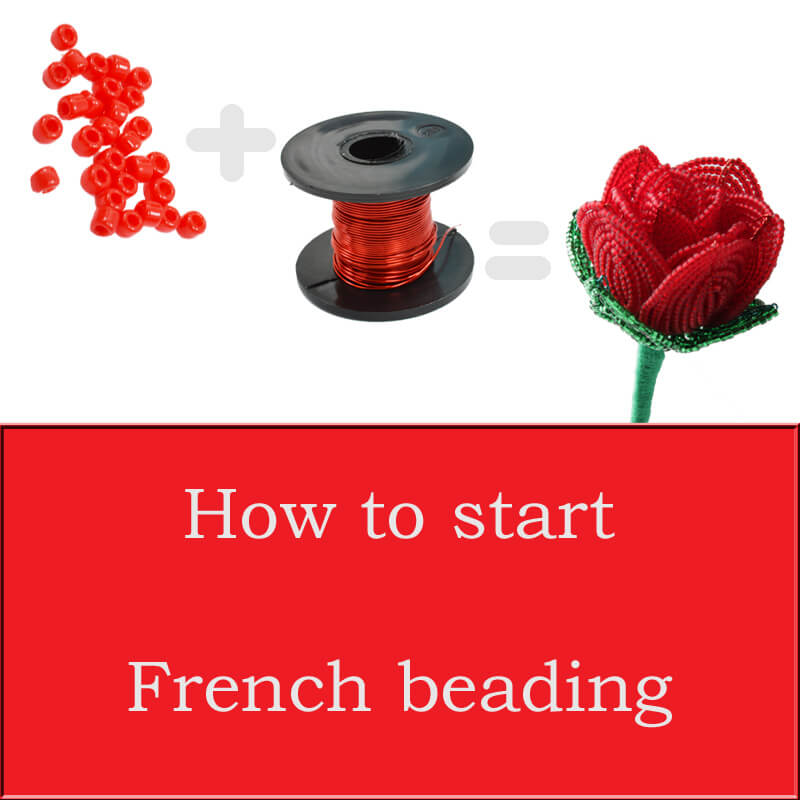
If you’re wondering how to start French beading, then you’ve come to just the right place. I’m going to just briefly tell you what French beading is (in case you don’t already know). Then I’ll explain what materials you need to get started. I will also be including links to beginner patterns and other helpful resources for learning.
So, let’s discover how to start French beading…
What is French beading?
French beading is an ancient craft with a rich and varied history. If you just want to learn about the history, then this book is the best I know of.
The craft itself is best summarised like this…
String seed beads onto wire. Then, you have a variety of options (techniques) for shaping the beads on your wire to make flowers, petals and leaves. You can assemble these components into individual flowers and create floral displays.
So, yes, this is basically a very specialised form of wirework. Now, the thing that has put me off getting into wirework is my belief that it needs a lot of specialist tools and processes. French beading isn’t that kind of wirework! So, you’re not going to need to hammer or prepare your wire. You won’t be coming across strange technical language.
Basically, this is a craft that is truly accessible to everyone.
Browse French beading patterns here>>
What beads do you need?
If you’re thinking about how to start French beading, you’ll be wondering about materials. You will already have worked out that you need some beads. So, which ones?
The majority of French beaded flowers are made with size 11/0 seed beads. You may find some that use size 8/0, but these aren’t common (unless you choose to use a larger size to scale up a flower).
Does the bead brand matter?
If you’re used to bead-weaving, then you’ll be used to the idea that not all seed beads are equal. So, what brand should you get?
Well, French beading is a lot more forgiving. So, you don’t need to use ‘precision’ beads like Delicas. You can get away with brands that have a few size differences.
Basically, you can use a cheaper brand of seed bead and the uneven beads will notice less than they would in a bead-weaving project.
Having said that, French beading is still a precise craft. You need flower petals to come out roughly the same size or the flower will just look weird. So if you try and use a really cheap, irregularly sized bag of seed beads, you won’t get the best results.
Practical advice
If you already have a stash of size 11 seed beads, you can just use those (although don’t waste those expensive Delicas on this!).
If you need to buy some beads for French beading, then go for a brand that is good, but not too expensive. My personal choice is Matsuno: these beads are pretty regular, but they are cheaper than Miyuki or Toho. Preciosa beads will also work well.
What wire do you need?
You probably also spotted that you need some wire for this. Typically, you are going to need 28ga (0.315mm if you’re European) and/or 24ga (0.5mm). You want wire that is sold on a spool because you will always work from the spool.
Nowadays, wire is available in a wide range of colours. So, it’s great if you can get colours to match your beads. This may not always be possible. So, just try to get a close match.
Now if you’re here to learn how to start French beading, you may still be experimenting. So, you probably don’t want to invest in loads of different reels of wire, only to find this isn’t something you want to keep on doing.
Practical advice
So, if you are just dipping your toe in the water, I would recommend you get some green wire and then a light, neutral colour. Ivory or silver is a good idea.
If you then fall in love with the craft, you can expand your colour range later.
Does brand matter?
You basically want a craft wire that is going to be strong and pliable. I use one particular brand which is manufactured here in the UK. You can check this out here>> I really can’t recommend it highly enough. Not only does it come in a great range of colours, but it is lovely to work with.
If you already have a brand of wire that you get on with, then use it. If you’re new to this, feel free to check out the brands offered by your local craft or bead store. See how you get on with them. But bear in mind that low price often also indicates low quality, so be cautious.
Other Materials
Unlike bead-weaving, you are going to need to invest in a few non-beading craft supplies. First up: stem wrapping tape. This is a floristry supply. So, you will find it in florists, or in some craft stores.
You will use this to wrap the stems of your flowers and plants. It has a naturally sticky texture that will adhere to your wire and create a neat finish.
Some people like to leave their stems at this point. Personally, I prefer to finish mine with embroidery silk. The brand of this really doesn’t matter. So, if you already have some lying around in your craft stash, use that.
Lastly, for some flowers, you may want to stiffen the stems. For this, you should use straight lengths of thicker green wire – I recommend 18ga or 20ga. Again, this is a material that is typically used in floristry. So, check out your local craft store or florist.
Before you rush out and buy all these supplies, check the French beading pattern you are using. It will give you more detailed instructions on the quantities, size and colours of the materials.
 How to start French beading… join my online class now
How to start French beading… join my online class now
What tools do you need?
I know you’re anxious to find out how to start French beading right now… I’ll get on to that very soon, I promise.
First, I need to introduce you to the tools. You’ll be happy to hear, there aren’t many required.
Wire cutters
You definitely need a pair of wire cutters. Whatever project you are making, you will need to cut the wire you work with.
You may already have some in your stash. So, then you’re good to go. If you need to buy some, go for a mid-range price. The very cheap cutters will break and blunt easily. If you’re just starting out, you don’t really need to invest in the most expensive until you have decided whether or not this is something you want to keep doing.
If you need more information and suggestions, try this blog>>
Bead Spinner
‘What on earth is that?’, I hear you ask. If you plan on doing a lot of French beading, it is essential. If you’re just dabbling to find out whether you enjoy the craft, then have a think about it.
A bead spinner is a really cool gadget that threads your beads onto your wire. It’s by far the fastest method of stringing beads. And you can use it for other types of beading too.
All I’m going to say is: it’s magic!
Other stuff
As you work, you are going to be twisting wire quite a lot. So, some people like to use a pair of flat nose pliers to help them grip the wire or beads to create a neat twist. This isn’t essential, but it is something you might like to try. If you want to find out more about flat nose pliers, check out this blog>>
Basically, if you have a pair in your existing toolkit, that’s great. If you don’t, then you really don’t need to rush out and buy some. I have survived for years without using them!
You will need some clear glue, though. This is to finish off your stems. So, when you have added the embroidery silk, just use a dab of glue to hold it in place.
Confession time: I am naughty and use my wire cutters to cut my embroidery silk! The cutters do a decent job, but I fear this may not be the best thing for their blades. So, it’s a better idea to have a pair of scissors to hand to cut your thread and save your wire cutter blades.
Browse French beading patterns here>>
How to start French beading right now…
So, here’s the bit you’ve been waiting for: how to start French beading right now.
Well, I’m assuming you’ve got together the list of materials and tools. The next thing you need is to learn some techniques. I’ll talk about some of these in my next blog. But you don’t need to wait until then…
Right here, this online class will get you started with video tutorials covering all the techniques you need to know to begin with. Then, you’ll learn how to make a great range of flowers, including roses, lilies and some filler flowers like Baby’s Breath. If you’re feeling ambitious, you can turn them into a bouquet, but you don’t have to. You can progress effortlessly from beginner to more advanced projects, working in your own time, whenever you choose.
If you’re not so desperate to start right away, then just stay tuned to my blog and I’ll be giving you a lot more information. Starting with techniques (read that one here), covering how to read French beading patterns and how to create your own arrangements. So, see you next time…



















